This document covers the following topics:
To perform development directly on a Natural server on which Natural
Development Server (NDV) is installed, you have to activate a Natural server
environment. You do this by mapping the appropriate server in the
Natural Server view. Each server provides all remote
services (such as access or update) for a specific FUSER (Natural
system file for user programs).
If you have chosen to work in local mode, the Natural Server view is only required for downloading libraries and objects to your Eclipse workspace. See Working with Natural Projects in Local Mode for further information.
If you want to connect to a Natural environment for the first time, you have to map it as described below. Once you have mapped an environment, a node for this environment is automatically shown in the Natural Server view. It is possible to map the same environment more than once, for example, if you want to have Natural server sessions with different session parameters.
![]() To map a Natural environment
To map a Natural environment
Go to the Natural Server view.
Invoke the context menu and choose Map.
Or:
Choose the following icon in the local toolbar:
![]()
The following dialog box appears.
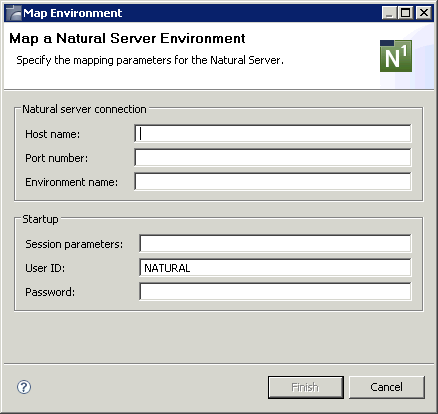
Specify the following information:
| Option | Description |
|---|---|
| Host name | The name of the Natural server. |
| Port number | The TCP/IP port number of the Natural server. |
| Environment name | The name that is to appear in the Natural Server view. A default name will be created automatically. If you want, you can enter a more specific environment name. |
| Session parameters | Optional. If dynamic parameters are required
for the Natural environment, specify them in this text box.
Tip: |
| User ID | The user ID that is to be used for mapping the Natural environment. This text box is initially blank. When you have previously mapped an environment, the user name that you entered the last time is automatically provided. |
| Password | Optional. If Natural Security is active on the Natural server, specify the required password in this text box. |
Note:
If you do not know the host name and port number for your Natural
server, ask your administrator.
Choose the button.
A node for the specified environment is now shown in the Natural Server view.
The following description applies if you want to switch to a different CICS transaction on a mainframe.
You specify the CICS transaction name in the same text box in which you also specify the dynamic parameters for the Natural environment. So that the CICS transaction name can be evaluated, it is important that you specify it before any Natural parameters, using the following syntax:
<TA_NAME=name>
where name can be 1 to 4 characters long. This must be the name of an existing CICS transaction which applies to a CICS Adapter. It will override the transaction name which is currently defined in the configuration file for the CICS Adapter on the Natural Development Server (NDV). Ask your administrator for further information.
Make sure to put the entire definition in angle brackets. When this definition is followed by a Natural parameter, insert a blank before the Natural parameter. Example:
<TA_NAME=NA82> STACK=(LOGON SYSCP)
If the specified CICS transaction name cannot be found, an error message occurs and the session cannot be started.
The Natural Server view provides the logical representation of one or more Natural environments. The following example shows two Natural server nodes, one for a server on a mainframe and another for a server on UNIX. The names that are shown for the server nodes are the environment names that have been defined when the environments were mapped.
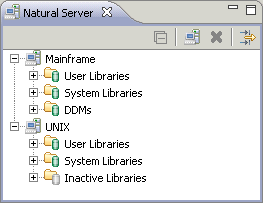
Specific top-level nodes are provided for user libraries and system
libraries (also known as the FUSER and FNAT system
files). Other top-level nodes correspond to the Natural architecture in the
mapped environment. For example:
In a mainframe environment, DDMs are always stored in the system file
FDIC. Therefore, a DDMs node is
available.
In a UNIX, OpenVMS or Windows environment, DDMs are normally stored
in libraries. However, if the parameter FDDM has been
set, the DDMs are stored in the system file FDDM. In this case, a
DDMs node is also available.
Inactive libraries are only available in UNIX, OpenVMS and Windows environments. Therefore, such a node is not provided for a mainframe environment.
Alias names can be shown for the system files in a UNIX, OpenVMS or Windows environment. They are shown when they have been defined with Natural on the appropriate platform.
When you expand the node for a system file, the nodes for the libraries in this system file are shown. For detailed information on the system files and library types, see the Natural documentation for the corresponding platform.
The objects in a library are grouped into different nodes, according to their Natural object types. For example, all programs are shown in a node called Programs. Thus, if you want to view the available programs in a library, you have to expand the Programs node.
For subroutines, functions, classes and DDMs, the long names (which may exceed 8 characters) are shown. These are the names that have been defined in the program; the names that have been defined when the object has been saved are not shown for these objects.
If Natural Security is active, only the allowed libraries and objects are shown. In addition, the commands which are not allowed to be used are disabled in the context menus.
You can use the
![]() button in the local toolbar to collapse all expanded nodes.
button in the local toolbar to collapse all expanded nodes.
Notes:
Using a filter, you can reduce the number of items that are shown in the Natural Server view. Filtering involves several steps: First you define a filter and then you apply the filter to a system file node or to a library node. Detailed information is provided in the following topics:
When you define a filter, you specify a pattern (for example, that only items are to be shown which start with the letter "L"). Each filter can hold an unlimited number of patterns.
The filters that you define can be applied to all mapped Natural environments.
![]() To define a filter
To define a filter
Choose the following icon in the local toolbar of the Natural Server view:
![]()
The Define Filters dialog box appears.

When filters are already defined, they are shown in the upper part of the dialog box. The lower part of the dialog box shows the patterns, if defined, for the selected filter.
Note:
This dialog box can also be invoked from the Set
Filters dialog box (see Setting a
Filter).
To define a new filter, choose the button in the upper part of the dialog box.
Enter the name for the filter in the resulting dialog box.
You can use any name for the filter (for example, "My Libraries").
Choose the button to close the dialog box in which you have defined the name of the filter.
Now, you have to define one or more patterns for the new filter.
Make sure that the filter is selected in upper part of the dialog box.
Choose the button in the lower part of the dialog box.
Enter the filter pattern in the resulting dialog box. A pattern is defined as follows:
You can enter the names of all libraries or objects that are to be shown. All names must be separated by a semicolon.
Note:
Instead of entering all filter criteria in one pattern, you
can also enter them by adding several patterns.
You can use wildcards (? or *) within the names if you do not want to enter each name individually. The question mark (?) may be specified at any position inside the name. The asterisk (*) is only allowed at the end of a name.
You can also enter a range of names. Ranges must be entered as follows:
name1 - name2
When defining a range, it is important that you enter a space before and after the hyphen. The spaces are necessary since names may contain hyphens. Without the spaces, name1-name2 would be interpreted as the name of a single library or object. Each name in a range definition may contain wildcards (see above). Example:
AL* - AM?TEST
Choose the button to close the dialog box in which you have defined the pattern.
In the Define Filters dialog box, choose the button to save your changes and to close the dialog box.
Each defined filter can be applied to a system file node or to a library node of a mapped Natural environment:
When you select a system file node (for example, User Libraries), you can reduce the number of libraries that are shown for this system file.
When you select a library node, you can reduce the number of objects that are shown in this library.
When a filter has been applied, the icons that are shown for the nodes contain an additional plus sign:
|
|
System file with an active filter. |
|
|
Library with an active filter. |
Note:
The label decorations for the filters are controlled by the
preferences under General > Appearance > Label
Decorations. If you do not want to have label decorations for the
filters, just go to the above mentioned preference page and deselect
Natural Server View Filter.
All filters that you set for a mapped Natural environment are stored with the environment name that is shown in the Natural Server view. For example, when you have defined "MyMainframe" as the environment name and you unmap this environment, the filters will be set again when you map the same environment once more with the same environment name (that is, with the name "MyMainframe"). If you map the same environment with a different environment name (for example, with the name "MyServer"), the filters that you have set for "MyMainframe" are not considered.
![]() To set a filter
To set a filter
In the Natural Server view, select the node(s) for which you want to set a filter (either a system file node or a library node).
Invoke the context menu and choose .
The Set Filters dialog box appears. It lists all filters that are currently defined.

Activate the check box for each filter that you want to set.
You can also use the following command buttons:
| Command Button | Description |
|---|---|
| Activates all filters in the dialog box. | |
| Deactivates all filters in the dialog box. | |
| Invokes the Define Filters dialog box in which you can define additional filters or change the existing filters. See Defining a Filter. |
Note:
When you select a filter (not the check box), the pattern for
this filter is shown at the bottom of the dialog box.
Choose the button.
When an automatic refresh has been defined in the Natural preferences (see Runtime Execution in Setting the Preferences), the content of the Natural Server view changes automatically so that just the items that match your filter pattern are shown (depending on your selection).
When an automatic refresh has not been defined in the Natural preferences, you have to refresh the display manually. See Refreshing the Display.
Notes:
You can either deactivate a filter for a node or you can remove a filter completely so that it is no longer available.
You can also remove a single pattern if you no longer need it.
![]() To deactivate a filter
To deactivate a filter
In the Natural Server view, select the node(s) for which you want to deactivate a filter.
Invoke the Set Filters dialog box as described above (see Setting a Filter).
Deselect the check box for each filter that you want to deactivate.
Choose the button.
![]() To remove a filter
To remove a filter
Invoke the Define Filters dialog box as described above (see Defining a Filter).
Select the filter that you want to delete.
Choose the button in the upper part of the dialog box.
Note:
When the selected filter is currently active, you are asked
whether you really want to delete the filter.
![]() To remove a pattern
To remove a pattern
Invoke the Define Filters dialog box as described above (see Defining a Filter).
Select the filter which contains the pattern that you want to delete.
Select the pattern that you want to delete.
Choose the button in the lower part of the dialog box.
When you select a node in the Natural Server view, the corresponding properties are automatically shown in the Properties view. The information that is shown in the Properties view depends on the type of node that is currently selected:
Natural Environment
Information on the selected Natural environment is shown. This
includes the mapping information.
Note:
More detailed information on a Natural environment is provided in
the Properties dialog box. See
System Information for a
Natural Environment.
System File, Library or Object Type
Information on the selected system file, library or object type is
shown, for example, database ID, file number, the number of different objects
(such as sources and cataloged objects) and their sizes.
Object
Information on the selected object is shown, for example, short name
and long name, programming mode, encoding, and date and time when the source
was last modified or cataloged.
Brief information on the selected node is also shown in the status line of the Eclipse window. For example, when a Natural object is selected, the following information is shown: environment name (with host name and port number), system file name (with database ID and file number), library name, object type (for example, "P" for program), and object name.
Note:
You can also invoke a Properties dialog box for
a node using the command from the context
menu.
In the Natural Server view, you can display detailed system information for each mapped Natural environment.
![]() To display system information for a Natural environment
To display system information for a Natural environment
In the Natural Server view, select the top-level node for a mapped Natural environment.
Invoke the context menu and choose .
The Properties dialog box appears, showing the system information for this environment.
In the tree on the left side of the dialog box, choose the type of system information that you want to display.
Information on the resulting page is provided in the topics below.
Note:
The information provided in the Properties
dialog box corresponds to the output of the Natural system commands
SYSPROD, SYSPROF and
SYSFILE.
When you choose General in the tree, general information about the current environment is shown.
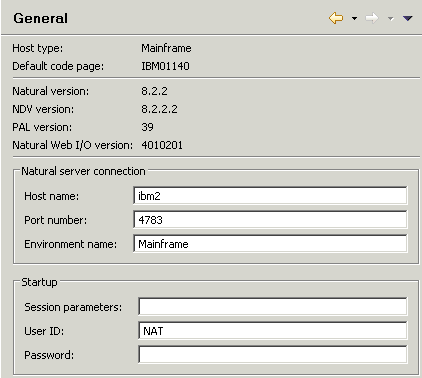
This information includes, for example, the Natural Development Server (NDV) version and the name of the default code page.
If you want to change the mapping (for example, in order to specify different session parameters or a different user ID and password), you can do this here. See Mapping a Natural Environment for information on the options that can be specified.
Note:
General information is also shown in the
Properties view when the node for a mapped Natural
environment is selected. However, it is not possible to modify information in
this view. See also Properties
for the Different Nodes.
When you choose Product Information (SYSPROD) in the tree, a list of all products that are installed in the Natural environment is shown.

Two different areas are available, a tree and a table. The information that is shown depends on the selected Natural environment.
The tree at the top lists all installed products in the Natural environment.
When you move the mouse pointer over a product name in the tree, a tool tip appears, providing information about this product. The same information is shown in the table at the bottom when you select the product in the tree.
For some products, it is possible to expand the product node in the tree:
Mainframe environments
You can display information on history records and/or
subcomponents.
Windows, UNIX and OpenVMS environments
You can display information on hotfixes.
The table at the bottom shows information about the entry which is currently selected in the tree. For example:
When you select the top-level entry Products in the tree, a list of all installed products is shown in the table. In this case, you can see the details for all products (such as INPL version number, INPL date and product ID) at a glance.
When you select a product in the tree, only the details for the selected product are shown in the table.
When you select, for example, a history record in the tree, the corresponding information is shown in the table.
When you choose System Files (SYSPROF) in the tree, the current assignments for all Natural system files in the Natural environment are shown.
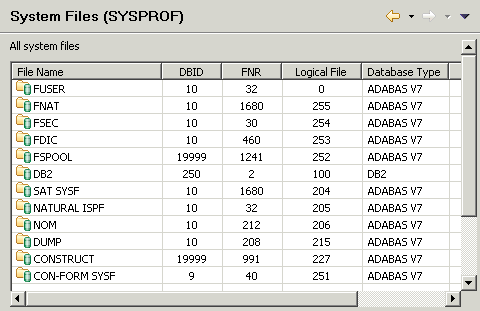
For each system file, detailed information such as database ID and file number is provided. The information that is shown depends on the selected Natural environment. The above example shows the system files in a mainframe environment. For Windows, UNIX and OpenVMS environments, additional entries for inactive system files can also be shown.
When you choose Work and Print Files (SYSFILE) in the tree, information about work files and printer settings is shown.

Several tabs are provided. The information that is shown depends on the selected Natural environment. The above example shows the tabs for a mainframe environment (work files and print files). In a Windows, UNIX and OpenVMS environment, tabs are provided for work files, reports and logical devices.
When you unmap a Natural environment, its node is removed from the Natural Server view.
Note:
Any editor windows that have been opened for an environment are not
closed when unmapping this environment. Even though the environment has been
unmapped, it is still possible to save to this environment any modifications
that you make in the editor windows.
![]() To unmap a Natural environment
To unmap a Natural environment
In the Natural Server view, select the node for the Natural environment that you want to unmap.
Invoke the context menu and choose Unmap.
Or:
Choose the following icon in the local toolbar:
![]()
The following topics are covered below:
Using the Natural command console for mainframes, you can enter Natural system commands directly in the Console view.
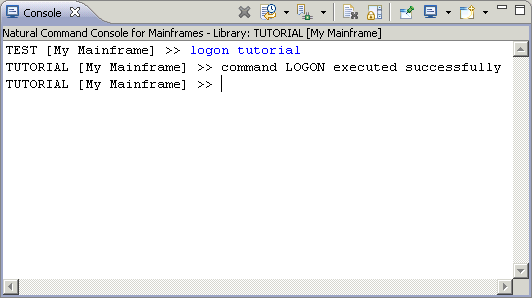
When a system command provides output (for example, when you execute
the LIST or TECH
command), the output (Natural I/O) is either shown in the internal browser or
in an external browser, depending on the settings in the Natural
preferences.
Application-dependent information (for example, "command LOGON executed successfully") and error messages (for example, "NAT0082 Invalid command, or Object XY does not exist in library.") are shown directly in the Natural command console, behind the input prompt.
Notes:
The Natural command console for mainframes is available in the Console view, in the list of registered consoles.
![]() To open the Natural command console for mainframes
To open the Natural command console for mainframes
Go to the Console view.
Click the "Open Console" icon
(![]() ) which is shown in the local toolbar of the
Console view.
) which is shown in the local toolbar of the
Console view.
From the resulting menu, choose .
When you select a node in the Natural Server view, the name of the corresponding server environment and library is shown in the header line of the Natural command console (for example, "Library: TUTORIAL [My Mainframe]". When a library is currently not selected in the Natural Server view, the Natural command console uses the default logon library.
As soon as you switch from the Natural Server view to the Natural command console, the environment information which is part of the command console's input prompt is adapted so that it shows the environment that was last selected in the Natural Server view. The environment that is shown in the input prompt is always used as the active environment for any subsequent Natural system commands that you enter.
In the Natural command console, you can change the environment with
the Natural system commands LOGON,
MAP and UNMAP. The change
is reflected in the header line and input prompt of the Natural command
console. The new environment is considered to be the active environment, and
any system command that you will now enter will be executed in the active
environment. The system command MAP adds a Natural
environment to the Natural Server view. The system command
UNMAP removes a mapped server environment from the
Natural Server view. For detailed information on the
system commands MAP and
UNMAP (and only for these two system commands which
are normally not available in a mainframe environment), see the Natural for
Windows documentation.
The current selection in the Natural Server view
is not affected when you change the environment in the Natural command console.
For example, when the library TUTORIAL is currently selected in
the Natural Server view and you log on to the library
TEST using the Natural command console, the library
TUTORIAL is still selected in the Natural
Server view. However, when you select a different library in the
Natural Server view, this change is immediately reflected
in the Natural command console and this library will become the active
environment.
The Natural command console for mainframes establishes permanent connections to the Natural servers that are accessed from the Natural command console. A connection to a server is established when the first Natural system command is issued in this server environment. Existing connections are activated and deactivated when the current server environment changes. All connections are closed when the NaturalONE session ends.
In addition to the functionality common to all Eclipse consoles (such as "Pin Console"), the Natural command console for mainframes provides the following commands:
| Icon | Command | Description |
|---|---|---|
| Close Console | Closes the Natural command console for mainframes. When you close the Natural command console, the command history (see below) is cleared. | |
| Natural Command History | Lists all commands that you have entered since the Natural command console has been opened. When you select a command, it is copied to the input prompt. You can then edit the command (if required) and execute it once more. Using the UP-ARROW and DOWN-ARROW keys, you can scroll through the command history. | |
| Set Selected Environment | Lists all server connections that have been established in the current Natural session. The currently active environment is marked. When you select a server environment from this list, this environment becomes the active environment and subsequent commands will be executed in this environment. |
Note:
As long as a Natural system command is being processed, the console
is set to read-only, a wait cursor is shown, and the above icons are disabled.